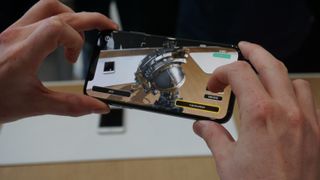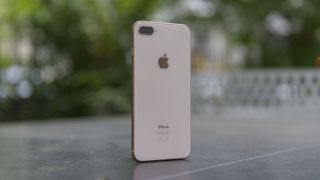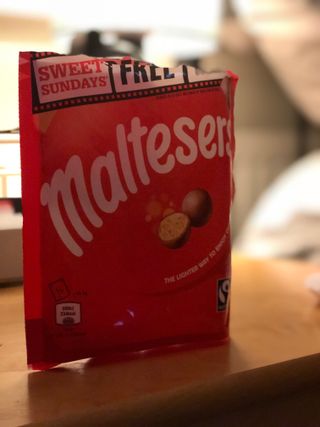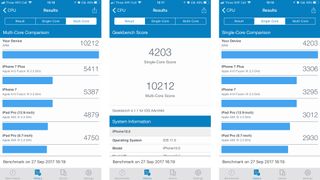Samsung Galaxy Note 8 – Design
The Note 8 is a stunning piece of design. While the Galaxy S8 and Galaxy S8+ have a friendly, more curvaceous design aesthetic, Samsung continues to nod at its business customers with slightly sharper edges and a squarer camera module. You still get the iconic InfinityEdge design where the left and right sides of the screen slope off to the side, and you get the ultra-thin top and bottom bezel to boot. I actually prefer it to the regular S phones, although others might disagree.
The whole lot is coated in Corning Gorilla Glass 5.0, and my unit lives up to its colour description of Midnight Black. It looks great out of the box, but after a little while of using it, greasy marks do begin to build up on the back. That’s not unique to this phone, and it looks far cleaner than many smartphones do after they’ve been subjected to my clammy palms.
YOU MIGHT ALSO LIKE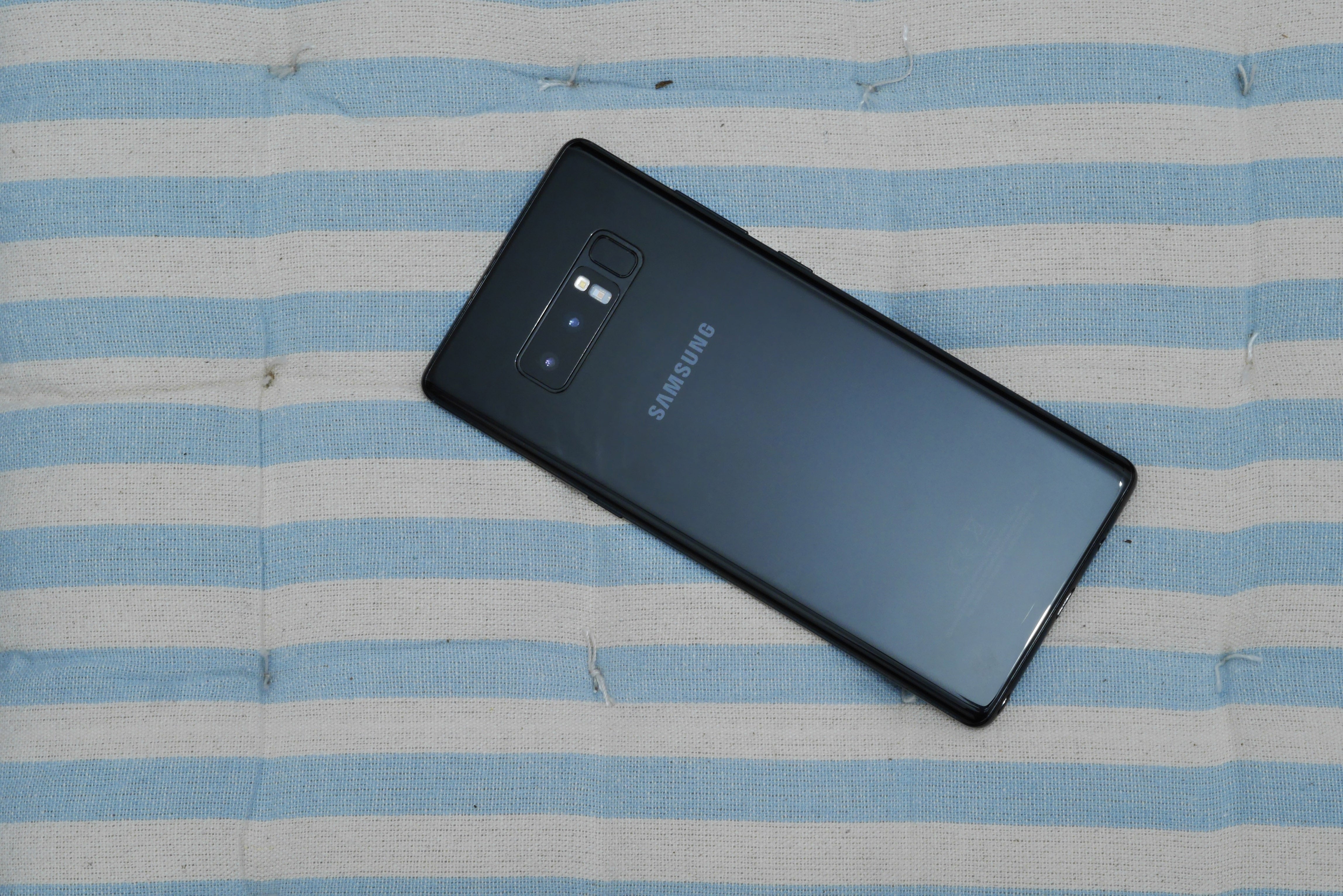
It’s hard for me to comment on the longevity of the glass coating on this device because I haven’t dropped it properly. However, experience from elsewhere tells me that even the latest glass phones won’t survive clumsiness: our mobiles editor, Max Parker, dropped the Galaxy S8 earlier this year and cracked it, while my wife dropped her (Gorilla Glass 4) Galaxy A5 2017 from table height and smashed the back panel to smithereens. The Note 8 is at least IP68-certified, meaning it’s waterproof even when subjected to a half-hour submersion.
I did drop the phone a couple of inches onto my kitchen counter at one point, and later laid it on a slightly rough stone table, and it came away without blemishes, as you’d well expect. The camera module has a very, very slight extruding border that protects the lenses from such behaviour. I did pick up one tiny mark on one of the exposed antennae on the top of the phone, which seems to have happened when it was in my pocket.
Sign up for the newsletter
As for features, let’s start with the front. There’s a front-facing camera and iris scanner inside the top bezel along with the earpiece and an LED notification light. On the bottom there’s nothing visible, although the lower portion of the screen is actually a pressure-sensitive home button that can be used to wake the phone. On the left edge you get the volume rocker and the Bixby personal assistant button, while on the right is the power button. The lower edge is home to the USB-C connector, 3.5mm headphone socket and pop-out S Pen stylus, as well as the loudspeaker. Finally, on the top, you get a SIM card/microSD card slot.
The camera module comprises of two sensors behind two lenses (more on these in the Camera section), an optical heart-rate monitor, LED flash, and a fingerprint scanner. I’ll save the fingerprint scanner for later, but I’ll say right here that on a phone this size, this is most certainly the wrong place for it and is almost impossible to reach when pulling the phone out of your pocket.
Its 6.3-inch screen might sound like a nightmare for the small-handed. In reality, thanks to the sloped edges, tiny top and bottom of the bezel, and slightly stretched 18.5:9 aspect ratio, it’s nowhere near as big as the 5.5-inch iPhone 7 Plus and other similarly chunky phones.
Credit: Max Parker / Trusted Reviews
It’s comfortable to hold in one hand, but less so to operate it effectively. If you’re just idly scrolling through Facebook then it’s fine, but as soon as you want to tap a button in the top half of the screen you’ll need your other hand, or to activate one-handed mode. One-handed mode is off by default but will be essential for many buyers and, once enabled, can be activated either by triple-tapping the home button or swiping diagonally up from the bottom corners.
Credit: Max Parker / Trusted Reviews
Samsung Galaxy Note 8 – Screen
At 2960 x 1440 pixels (‘WQHD+’, 522ppi), the 6.3-inch panel certainly isn’t left wanting when it comes to resolution. Trouble is, you’ll rarely see that many pixels being put to good use. In its default ‘optimised’ power state, the Galaxy Note 8 only renders apps and photos at 2220 x 1080 pixels (‘FHD+’, 392ppi), and 1480 x 720 pixels (‘HD+’, 261ppi) when in power-saving mode. It’s only when you switch on Performance mode, to the detriment of battery life, that the Note 8 actually fires on all cylinders and pixels.
Related: Best Android phones
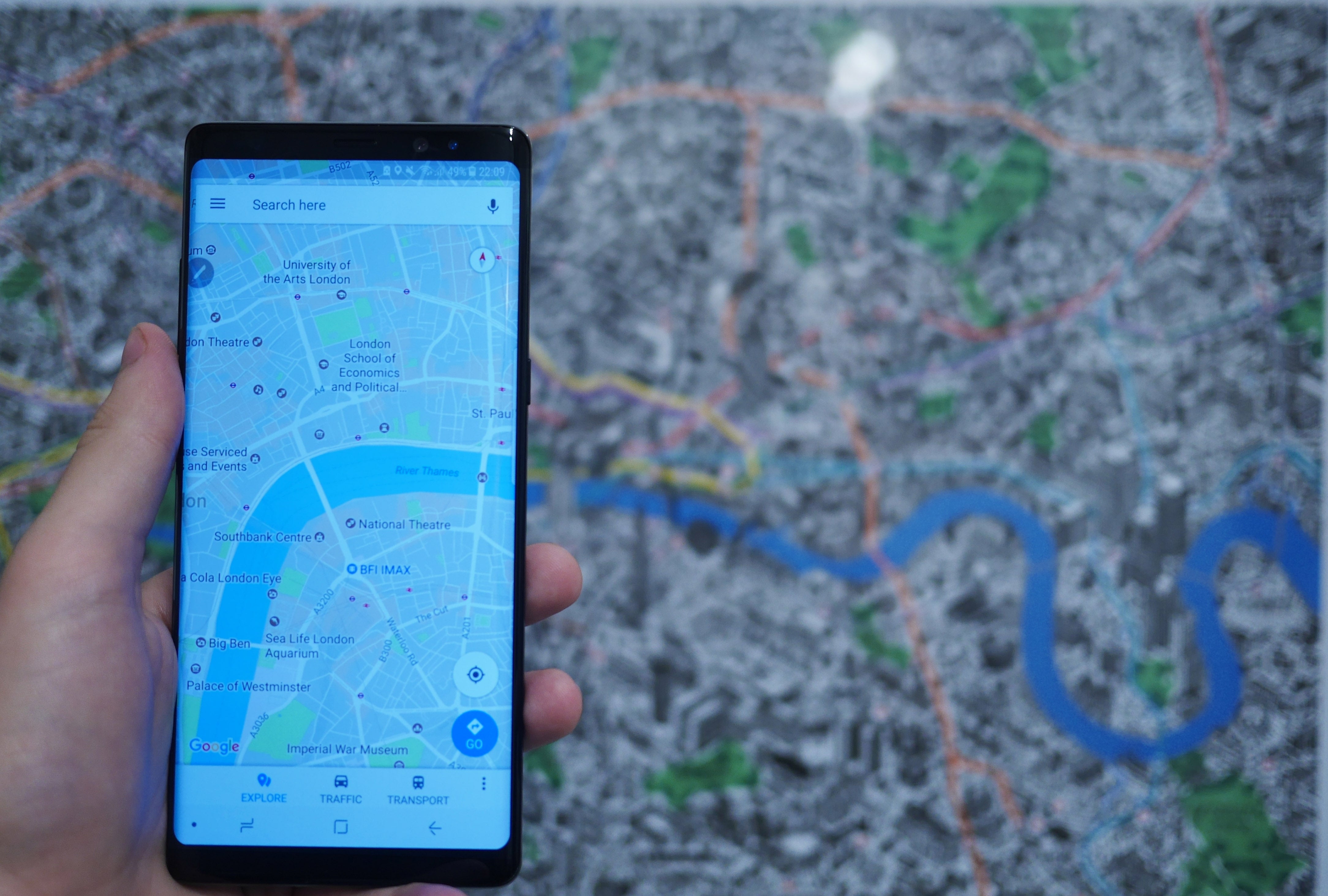
To many users, this will be confusing. Why have so many pixels when you’re not going to be using them to their full effect? When in FHD+ mode, 2.3 million dots are being dealt with by 4.2 million physical pixels, which seems like a waste. Indeed, only serving up FHD+ saves processing power, but doesn’t save any power from the screen itself.
Complexity aside, even when in its standard mode, the screen is stonkingly good. When it needs to, it can rise to an eye-searingly bright 1200 nits. For for the uninitiated, a good laptop screen will get to about 300 nits and a top-end HDR TV will generally get to around 1000 nits. That’s unbelievably bright, although it’s hard to verify because even with automatic brightness switched off the screen refuses to go beyond 340 nits under normal conditions. I suspect you’ll only ever get to 1200 nits when watching HDR compatible content from YouTube and Netflix, both of which look fantastic.
The AMOLED display manages clean whites, rich colours and only a hint of motion blur when scrolling through text. There’s a slight blue tinge if you view the phone off-centre, and the two sloping edges lose some brightness and clarity, which is a bit disappointing, if not surprising.
With the screen turned up to its full WQHD+ resolution, text is super sharp and crisp, as are high-resolution photos. But, I’ll be honest, you’d be hard-pressed to spot the difference in everyday use. I suppose this conclusion sort of justifies Samsung’s decision to disable the full resolution by default, but that doesn’t change the fact that this super-expensive screen is being wasted most of the time.
Because of the odd aspect ratio, you have to explicitly set each app you open to be stretched to the full length of the screen. So far I’ve had no problems with this. The only other downside is that most online videos are in a 16:9 aspect ratio, which means your video will have black bars either side of it, or you can stretch and crop the video so it fills the screen. Some widescreen movies actually benefit from the latter, but you’ll need to decide on a video-by-video basis.
One final function of note is the always-on screen. Because AMOLED pixels are self-lighting (they only consume power when they’re not black, unlike conventional LCDs that are always on), you have the option of keeping the display on with a black and white clock, battery information and media buttons.
This is great, until you check out Samsung’s power options and realise that having it on can decrease battery life by over an hour a day. What’s more, it doesn’t seem to turn off even when the phone is in your pocket, wasting even more precious energy. It’s a great feature on Samsung’s other phones, but when battery capacity is so tight, it’s the first thing you should turn off.

Samsung Galaxy Note 8 – Software
It used to be fashionable to complain about Samsung’s TouchWiz design. Techie folk loved to whine about its childish icons, rubbish bloatware, weird sound effects and slightly sluggish performance. This is no longer the case, and the freshly re-branded Samsung Experience is a mature Android skin, bringing not a merely good experience to the table, but something that genuinely sets it apart from other Android phones.
There are far too many unique features to talk about here, but one that has to get a mention – mostly because it has a dedicated button – is Bixby. Mobiles editor Max Parker wasn’t impressed by Bixby in its first iteration, but since then Samsung’s personal assistant has learned to respond to commands in English.
I like the fact that Bixby only listens when you hold down the Bixby button. Commands such as ‘Open Facebook and write a new status that says “Best day ever”’ work perfectly, as do actions like opening the Settings app in the Display section, making a phone call and opening the camera. Google Assistant can do your camera and phone call task, but not the Facebook or Settings commands.
What’s clear is that there’s a long way to go. Bixby doesn’t hear the nuances of British English (it only supports US English) so often gets things wrong, especially names. It also insists on encouraging you to use it more by giving you ‘XP’, informing you how much you’ve earned in a pop-up with an on-screen animation which not only makes noise, but also takes over half the screen. To be honest, most of my Bixby usage so far has been accidental, normally when pulling my phone out of pocket. It’s nowhere near ready for the prime time.
Related: Best phones to buy
 Left: An attempt at a joke. Middle: You can check your command history and give feedback. Right: British place names and some app names are beyond Bixby
Elsewhere, the experience is great. From the home screen you can swipe up or down to open your app drawer, and the notifications pane and quick options are non-obtrusive. The Edge Pane is just terrific, allowing you to put all manner of app shortcuts and other tools within a swipe’s reach, no matter which app you have open.
Left: An attempt at a joke. Middle: You can check your command history and give feedback. Right: British place names and some app names are beyond Bixby
Elsewhere, the experience is great. From the home screen you can swipe up or down to open your app drawer, and the notifications pane and quick options are non-obtrusive. The Edge Pane is just terrific, allowing you to put all manner of app shortcuts and other tools within a swipe’s reach, no matter which app you have open.

Left: An attempt at a joke. Middle: You can check your command history and give feedback. Right: British place names and some app names are beyond Bixby
There are loads of Edge apps to add, and they can be accessed with a single swipe
Samsung Experience is also very customisable, with themes, icon sets, fonts and more downloadable from the Samsung Themes or Galaxy Apps store. They vary in quality, but it seems to be curated by a human, so good stuff should find its way to the store fronts. The only thing I hate? The default emoji set, which can’t be changed.
There are loads of Edge apps to add, and they can be accessed with a single swipe
Sign up for the newslettere
The Galaxy Note 8 handles split-screen apps really well, and it’s even possible to create Edge shortcuts that open two apps simultaneously in split-screen mode.
The process of unlocking your phone can be done in many different ways. This is a good thing, because the fingerprint scanner is in such an illogical and hard-to-reach place, I don’t use it at all.
There are other options: the iris scanner is pretty fast but a non-starter for me, because it doesn’t work if you wear glasses. There’s also facial recognition that only lets you register one version of your face. This, again, can be annoying if you scanned your face with glasses on and try and unlock with them off, because it won’t always work. It was my unlock method of choice, although it was reliable maybe 90% of the time, which left me reaching for my pattern unlock more often than I’d have liked.
Samsung Galaxy Note 8 – S Pen
The S Pen is a passive (no battery needed) stylus that sits in its own dedicated nook. It’s great, and is the most natural writing experience I’ve found on any device, perhaps aside from the Microsoft Surface Pro‘s Surface Pen. The screen supports over 4000 pressure sensitivity points, meaning tiny adjustments in pressure will change how your scribbles appear.
Its integration into Android isn’t just a few random note-taking apps; this is a proper, whole-hearted extra layer that works really well. The most obvious is its ability to take super-quick notes when the phone is in standby. Just pull out the stylus and the screen will turn on, allowing you to jot a quick note without having to go through the rigmarole of unlocking it tapping around.
Related: What’s the best iPhone?
 Left: The PenUp app is a digital colouring book. Middle: The built-in notebook shrinks your messy writing so it goes between the lines. Right: All the tools accessible from the S Pen menu
Better still is the shortcut wheel that can be found when you press the pen’s single button. This brings up not just the ability to create a new note, but also take an instant screenshot and write on it, translate what’s on screen and even start a screen recording to be saved as an animated GIF. You can also add your own shortcuts to the wheel if you have an app you use frequently with the S Pen.
Worried about losing the stylus? There’s an alarm that will sound if you start moving without docking it safely away.
There’s a bizarre missing feature, though. The Note 8 supports handwriting recognition – you can write directly onto the keyboard and it’ll translate your scrawls into text – but the Samsung Notes app provides no way of turning your notes into plain text.
Overall, though, the S Pen is a genuinely useful feature and not a gimmick, but is it worth the price premium over the standard Galaxy S8+? That’s up to you to decide
Left: The PenUp app is a digital colouring book. Middle: The built-in notebook shrinks your messy writing so it goes between the lines. Right: All the tools accessible from the S Pen menu
Better still is the shortcut wheel that can be found when you press the pen’s single button. This brings up not just the ability to create a new note, but also take an instant screenshot and write on it, translate what’s on screen and even start a screen recording to be saved as an animated GIF. You can also add your own shortcuts to the wheel if you have an app you use frequently with the S Pen.
Worried about losing the stylus? There’s an alarm that will sound if you start moving without docking it safely away.
There’s a bizarre missing feature, though. The Note 8 supports handwriting recognition – you can write directly onto the keyboard and it’ll translate your scrawls into text – but the Samsung Notes app provides no way of turning your notes into plain text.
Overall, though, the S Pen is a genuinely useful feature and not a gimmick, but is it worth the price premium over the standard Galaxy S8+? That’s up to you to decide

Left: The PenUp app is a digital colouring book. Middle: The built-in notebook shrinks your messy writing so it goes between the lines. Right: All the tools accessible from the S Pen menu
